Email Address enquiry@pellet-richi.com
Phone/Whatsapp 0086-13838389622
Email Address enquiry@pellet-richi.com
Phone/Whatsapp 0086-13838389622

The production of energy by means of biomass has shown a clear trend towards the use of pellets due to their homogeneous size, which facilitates handling and feeding while also reducing costs associated with storage and transportation. The pellet quality depends on the properties of the feedstock and on the operative variables of the densification process. Quality parameters can be modified by adapting the process to the raw material to be pelletized. According to our experience in industries of biomass, we have designed MZLH biomass pellet mill, which can be used efficiently to produce pellets of different raw biomass materials, which enables our customers get maximum benefits from it.
The Biomass Pellet Mill is mainly a kind of mechanical equipment that uses wood or crop waste as raw material, which is crushed, pressurized, densified, shaped, and extruded into small rod-shaped solid pellet.
The specific uses of biomass pellet mills are as follows:
Pellets processed by biomass pellet mills can be used in many industries and are suitable for many raw materials, but for now, biomass pellets are mainly used to process fuel pellets.
The volume after molding is 1/30 ~ 40 of the volume of the raw material, the specific gravity is 10 ~ 15 times (the density is 0.8 ~ 1.4), the calorific value can reach 3400 ~ 6000 kcal, and it is a high-volatile solid fuel.

Biomass raw materials for bio pellets can be categorized into forestry, agriculture and waste‐based materials, and they can be subdivided into primary sources (directly produced materials) or secondary sources (derived from other processes).
The raw materials studied range from wood species, such as pine, spruce, beech, oak, poplar, aspen, salix, and fir, to agricultural residues, such as alfalfa, barely, canola, oat, wheat, rice, soybean, rye, reed canary grass, corn stover, corn cobs, switch grass, big blue stem, sugar cane bagasse, cotton, olive residues and peanut hulls and also mixed residues.
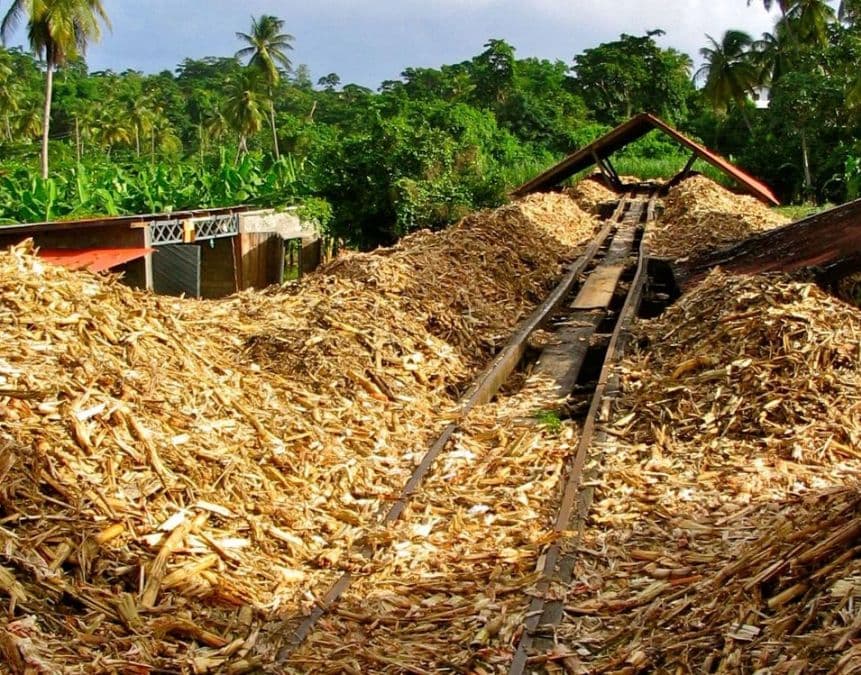


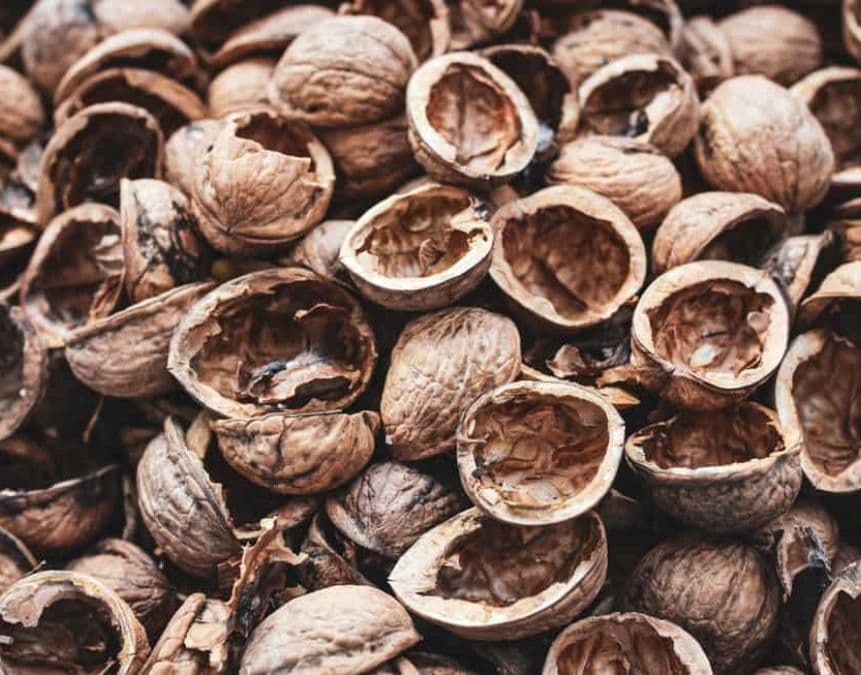
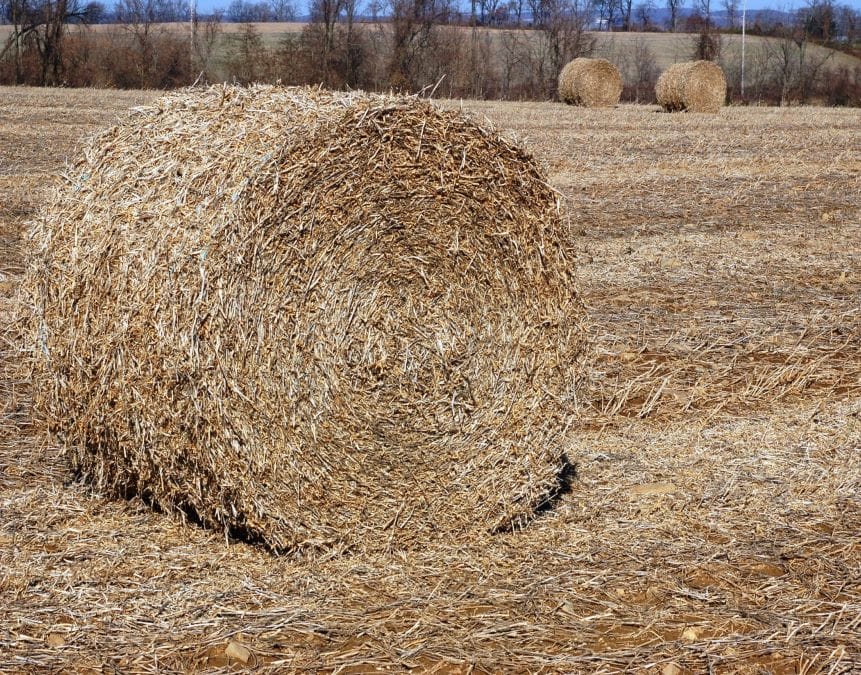
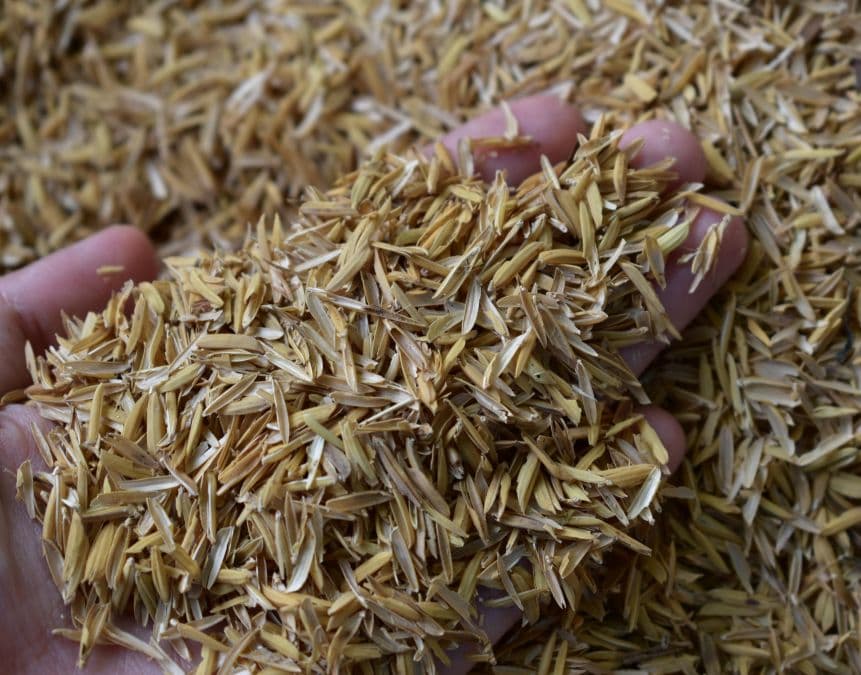
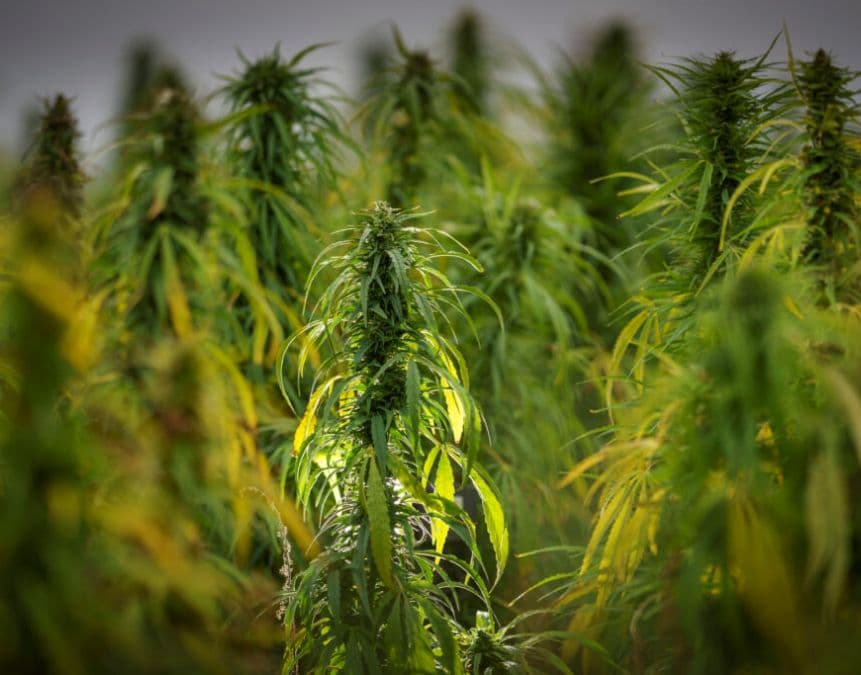

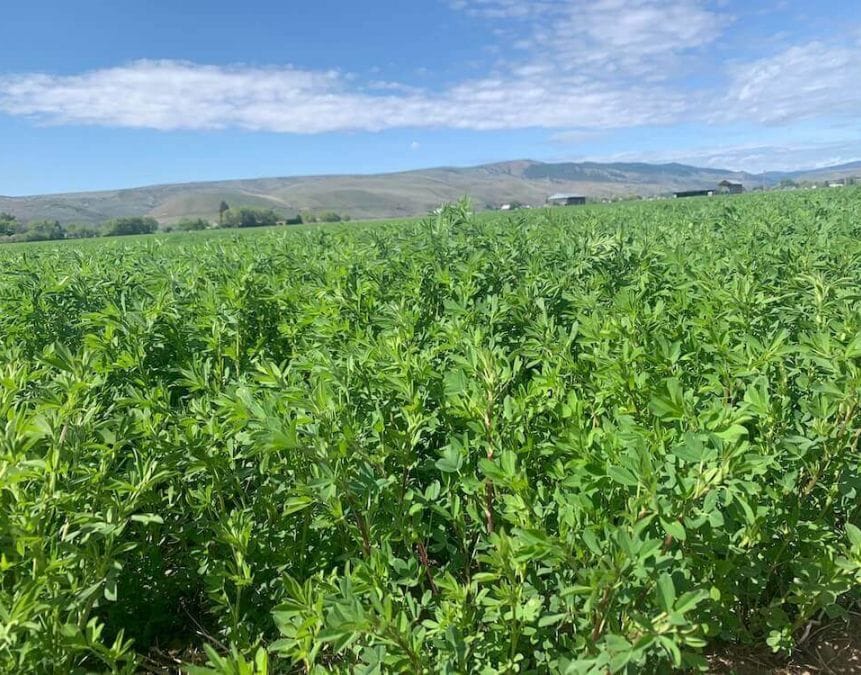


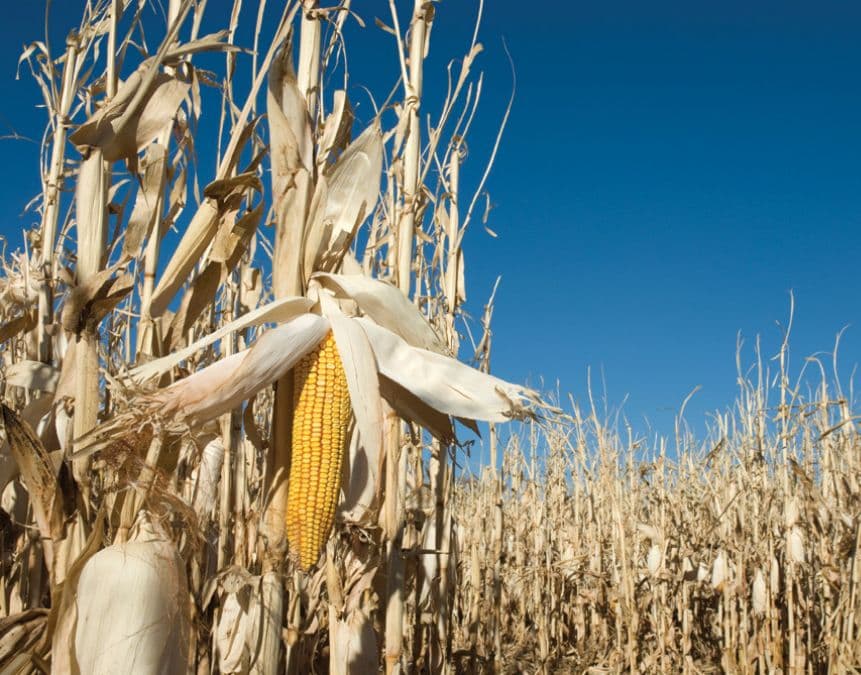
The applicability of biomass granulator is extremely wide, and this wideness is mainly reflected in the applicability of raw materials. According to different raw materials, biomass pellet mill machines can be divided into the following:









Pellets are produced in a biomass pellet mill machine that generally consists of a die with cylindrical press channels and rollers that force the biomass to flow into and through the channels. Due to the friction between the steel surface and the biomass in the press channel, a high back pressure is built up and heat is generated.
The physical forces built up in the press channel of a biomass pellet forming machine are crucial for understanding and optimizing the pelletizing process. A ring die with press channels and roller(s) are the basic parts of a biomass pellet making machine.
| Type | MZLH320 | MZLH350 | MZLH420 | MZLH520 | MZLH768 | MZLH858 |
| Output(t/h) | 0.7-4 | 1~6 | 2~10 | 3~15 | 4~30 | 5~40 |
| Main motor power(kw) | 22 | 37 | 90 | 132 | 250 | 280 |
| Main motor series | 6/8P | |||||
| Forced Feeder (KW) | 1.1 | 1.5 | 1.5 | 1.5 | 2.2 | 3 |
| Conditioner Power(kw) | 2.2 | 4 | 7.5 | 7.5 | 11 | 15 |
| Ring die diameter (mm) | 320 | 350 | 420 | 520 | 762 | 858 |
| Finished pellet diameter (mm) | 2-12 | |||||
| Device Configuration | Ring die material: 42CrMo Stainless steel conditioner Door of pelleting room: 6mm /SUS304 Forced feeding: Worm gear reducer Gear box: HT250 Gear: 42CrMo Gear shaft: 42CrMo Spindle: 42CrMo Empty shaft: 42CrMo Bearings: The gear shaft and main shaft bearings are SKF, and the pressure roller bearings are domestic high-quality bearings Oil seal: Germany/Taiwan Overload mechanical protection: safety pin Serpentine spring coupling drive Lubrication system: Configurable automatic oil injection system |
|||||




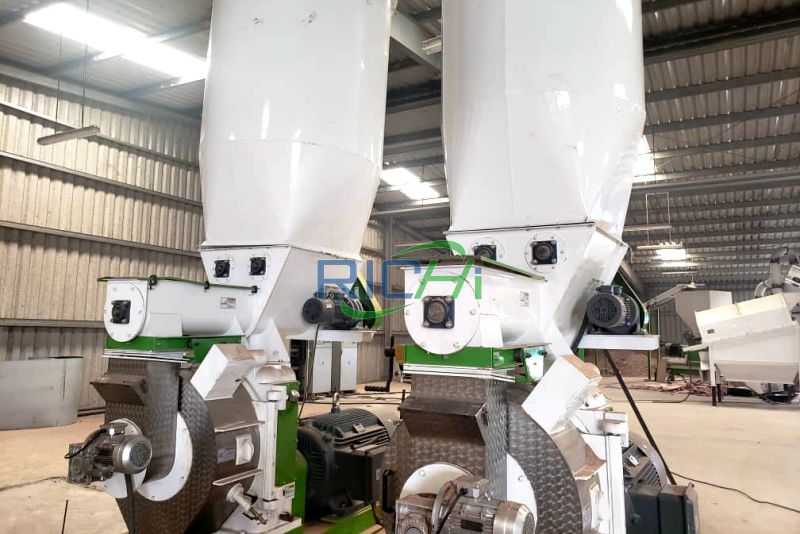
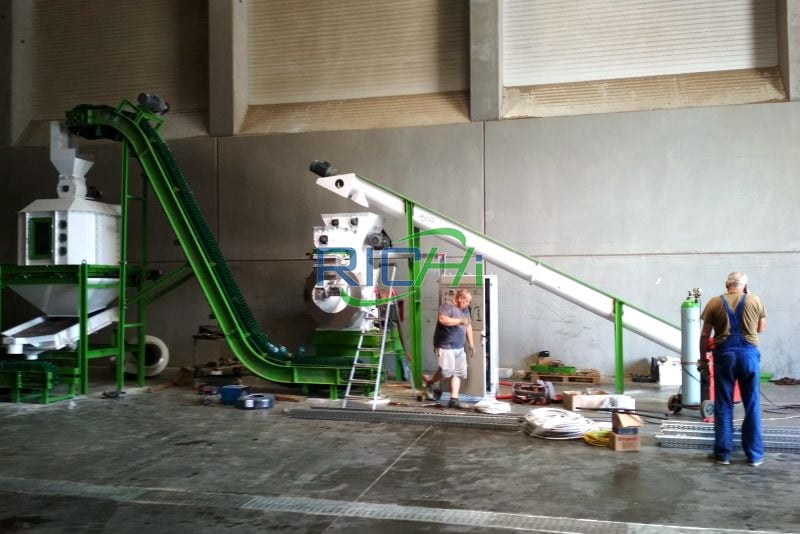
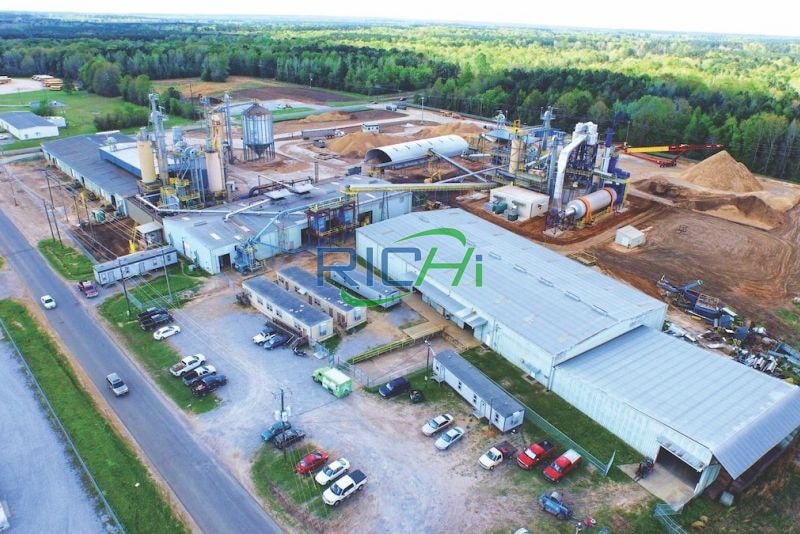
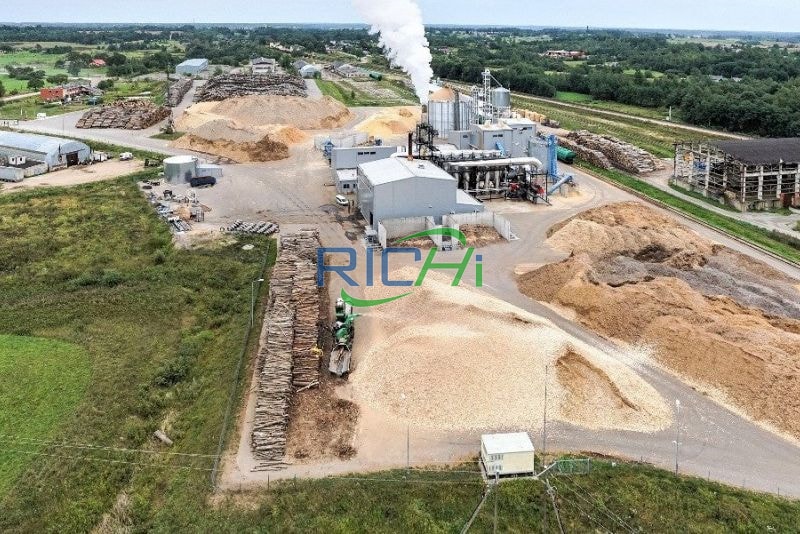
Choosing a professional and experienced partner is a shortcut to success. We are committed to providing you with the most professional biomass pellet mill solutions, whether it is biomass pellet plant construction or pellet plant technology upgrading.
Over the past 30 years, we have helped biomass pellet mill customers in the Indonesia, United States, German, Thailand, Canada, Germany, United Kingdom, Australia, Malaysia, Chile, Serbia, Thailand, Vietnam, South Korea, and many other countries around the world to achieve success. Trust us, RICHI Machinery will be your most reliable partner. Utilize our expertise and experience to help you achieve excellence in biomass pellet production. If you need anything, contact us for FREE!
Richi Machinery have provided 1-40t/h biomass pellet production lines, biomass pellet manufacturing plants and single biomass pellet making machines for hundreds of biomass pellet manufacturers, and we hope that in the future, we can also help you successfully realize a high-efficiency, high-quality, and high-return biomass pellet production business.
The followings are some biomass pellet plant project proposal / biomass pellet business plan/ biomass pellet manufacturing project report for you:
In today's growing energy demand, biomass pellet mill machines have been widely welcomed as an efficient and environmentally friendly energy equipment. However, how to choose a suitable biomass pellet machine has become a problem for many people.
Here will be a detailed discussion on "How to choose a biomass pellet mill" to help you choose the equipment that best suits you among the many brands and models.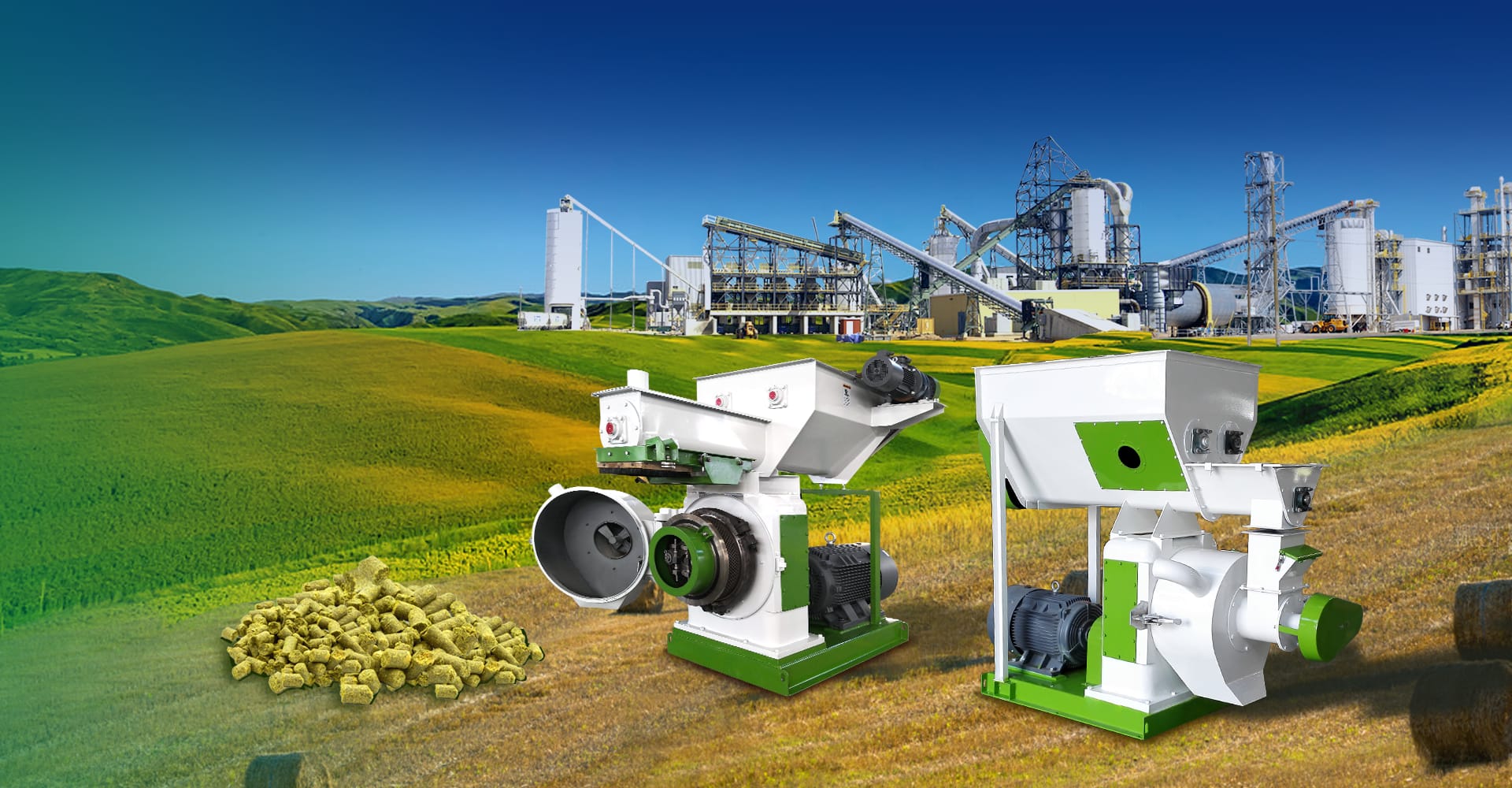
01
Clear purpose
First, we need to clarify the purpose of the biomass pellet mill. Is it used for home heating or industrial production? Different uses require different biomass pellet machine models and outputs. Therefore, when choosing a biomass pellet machine, we need to consider it based on actual needs.
02
Consider output
The output of the biomass pellet extruder machine is another important factor to consider. Different application scenarios require biomass pellet machines with different outputs. If the output is too large, it may lead to waste; if the output is too small, it may not meet actual demand. Therefore, when selecting a biomass pellet machine, it is necessary to determine the appropriate output based on actual needs.
03
Understand the machine quality
Machine quality is one of the important factors to consider when choosing a biomass pellet mill. A high-quality biomass pellet machine can ensure long-term stable operation of the equipment, improve production efficiency, and reduce the cost of maintenance and replacement of parts.
Therefore, when choosing a biomass pellet machine, we need to understand information about the equipment's materials, processes, and performance, and choose equipment with reliable quality.
04
Pay attention to energy consumption
Energy consumption is one of the important factors to consider when choosing a biomass pellet press machine. The energy consumption of the biomass pellet machine directly affects the production cost. When choosing a biomass pellet machine, we need to pay attention to the energy consumption of the equipment and choose equipment with lower energy consumption.
05
Consider ease of operation
Ease of operation is one of the important factors to consider when choosing a biomass pellet machine. The easy-to-operate biomass pellet mill can reduce labor costs and improve production efficiency.
Therefore, when choosing a biomass pellet machine, we need to understand the operation mode and operating interface of the equipment, and choose equipment that is easy to operate and maintain.
06
Consider price
Price is one of the important factors to consider when choosing a biomass pellet machine. The prices of biomass pellet mill machines of different brands and models vary greatly. When choosing a biomass pellet machine, we need to choose the right equipment according to our budget. At the same time, we must also be careful not to just pursue cheap prices and ignore the importance of other factors.
07
Understand after-sales service
After-sales service is one of the important factors to consider when choosing a biomass pellet mill. Good after-sales service can ensure the long-term stable operation of the equipment and reduce the trouble of repairing and replacing parts.
Therefore, when choosing a biomass pellet machine, we need to understand the manufacturer's after-sales service and choose a brand and model with good after-sales service.
To sum up, there are many factors to consider when choosing a suitable biomass pellet mill, including usage, output, machine quality, energy consumption, ease of operation, price and after-sales service.
Only by comprehensively considering these factors can you choose the biomass pellet machine that best suits you. At the same time, you also need to be careful not to pursue only one aspect of the equipment and ignore the importance of other factors.
What kind of biomass pellet mill manufacturers are trustworthy?
The biomass pellet mill machine is a new type of environmentally friendly equipment that uses biomass energy to produce. It can convert agricultural and forestry wastes such as sawdust, straw, rice husks, etc. into biomass pellet fuel. The use of biomass pellet machines can not only solve the problem of agricultural and forestry waste disposal, but also bring great convenience to our lives.
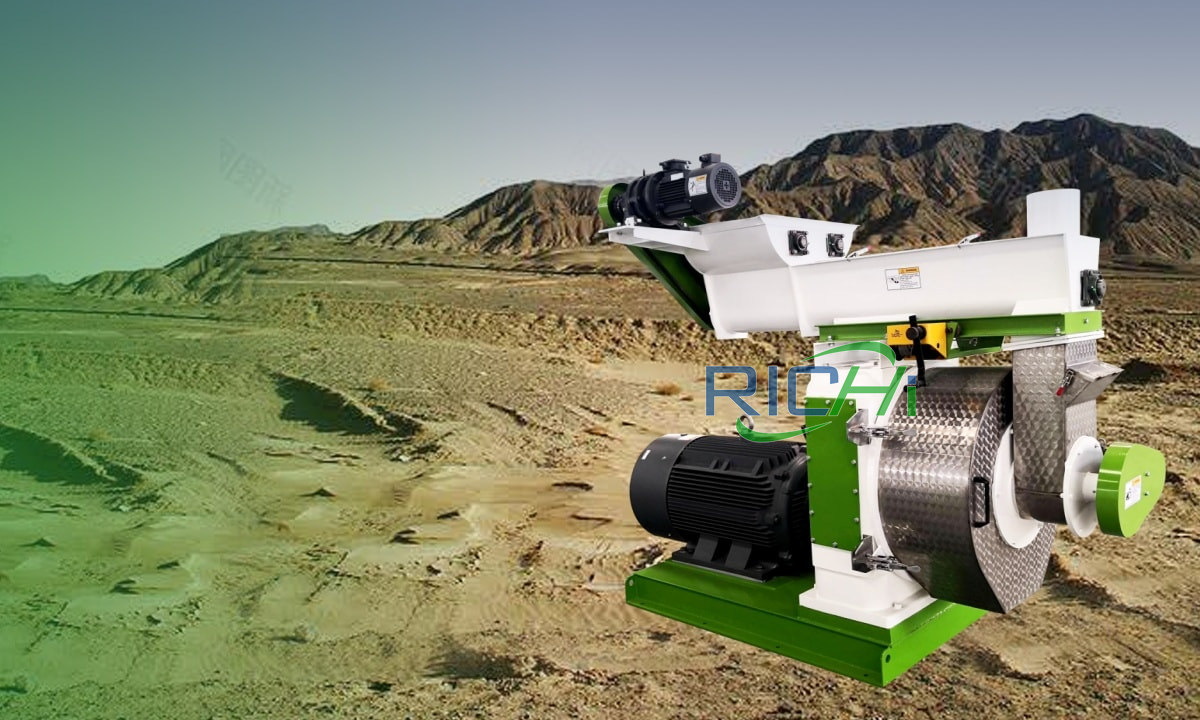
The primary working principle of the biomass pellet making machine is to compress agricultural and forestry waste through high temperature to form pellet fuel with high density and high combustion value.
Compared with traditional fuel and coal, this new type of fuel has higher combustion efficiency and generates greater heat. It is worth noting that during its combustion process, the emission of pollutants is extremely low, which is beneficial to environmental protection.
In the current society, energy shortage and environmental pollution problems are becoming increasingly serious, and the application of biomass pellet machines has great prospects. Its use can improve energy utilization and reduce the impact of waste on the environment. It can also reduce the company's energy costs and improve production efficiency.
In addition, the market demand for biomass pellet mills is also increasing year by year. With the improvement of environmental awareness, more and more companies and individuals are paying attention to and using biomass pellets.
With the continuous advancement of scientific research and technology, the working efficiency and pellet quality of biomass pellet machines are also constantly improving, which undoubtedly brings a broader market space for the development of biomass pellet machines.
In the future, as the environmental protection policies of various countries around the world continue to improve, biomass pellet mills will receive more support and promotion. We have reason to believe that biomass pellet machines will play a more important role in the fields of environmental protection and energy conservation in the future.

Wood and agricultural biomass pellets boost the potential as bio-fuels toward power production in tertiary and residential sectors. The production of pellets, however, is a multi-stage process where the supply-processing phases and the overall energy input strongly depend on the characteristics of the input biomass.
Generally speaking, just using a biomass pelletizer cannot support efficient biomass pellet processing, and equipment such as good quality biomass sawdust hammer mill, high efficiency wood chips, high drying efficiency biomass rotary dryer, biomass pellet cooler machine, pellet screening machine, biomass pellet bagging machine, etc., sre also required.
Complete biomass pellet manufacturing process:

01
Biomass materials supply
This section includes the collection, transport, and storage of biomass to the collection point; green wood is mechanically removed, and pruning residues are air-dried.
02
Biomass pre-treatments section
This section includes the mechanical processes such as converting wood into wood chips (except when starting from sawdust), the removal of ferrous material, drying, milling, and conditioning. The wood chips are typically dried in heaters fed with conventional fuel, although sometimes the heaters use wood chips as fuel. The most common driers use rotating drums with flow of air, in which the wet biomass does not stick to the drum surfaces and over-heating is minimized.
If the biomass can withstand contact with the combustion products, the simplest and cheapest system is a direct-heating wood drier, in which the wet biomass is in contact with hot combustion gases. Alternatively, the wet biomass can be dried using hot air. The dried biomass is further milled to obtain wood chips with average length of 3 mm and to homogenize the end product.
The most common biomass material hammer mills use rotating hammers, and the material is shifted through the machine using compressed air. Sometimes, the secondary milling is bypassed by a simple tilted-plane mechanical size selector.
Additives aimed at improving biomass quality and extrusion behavior can be added to the raw materials during this section.
03
Pelletizing section
This section involves the physical production of the biomass pellet by applying mechanical pressure on the biomass through a suitable holed plate, to obtain pellets with diameters in the 2–12 mm range and heights in the 12–18 mm range. The main technical parameters of the biomass pellet making machine are as follows: canal geometry, number and speed of pressurizing drums, ratio between diameter and length of canals, and distance between drum and holed plate. The devices may use a vertical cylindrical holed drum or a plane plate.
04
Post-Treatments section
These sections include cooling, screening (selection of pellet size), collection, and storage in silos or sacks for subsequent sale. The cooling section is critical for the stabilization of the product, since, during the biomass pelletizing section, the pellets reach comparatively high temperatures (90–95℃) and are typically obtained via forced exposure to air at room temperature. Pellets with a non-standard size are mechanically removed to minimize development of dust in the storage areas.
Pelleting plays a significant role in biomass pellet line production as the act of pelletizing breaks down plant based structures, facilitating optimal energy withdrawal while simultaneously reducing original structure size and densifying raw materials to reduce shipping and handling costs. The application of biomass pellets is increasingly widespread, but the application as fuel pellets is still dominant. Therefore, it is still necessary to discuss the raw materials of biomass pellets.
| Raw material | KJ/Kg (KiloJoule/Kg) | Kcal/Kg (Kilo calories/Kg) | ||
|---|---|---|---|---|
| lower calorific value | higher calorific value | lower calorific value | higher calorific value | |
| Softwood | 17500 | 21100 | 4183 | 5043 |
| Hardwood | 18600 | 20700 | 4445 | 4947 |
| Miscanthus/Napier grass | 17800 | 19100 | 4254 | 4565 |
| Switchgrass | 16800 | 19100 | 4015 | 4565 |
| Bamboo | 19000 | 19800 | 4541 | 4732 |
| Alfalfa | 17030 | 18500 | 4070 | 4422 |
| Lucerne | 17700 | 19000 | 4230 | 4541 |
| Cotton gin trash | 15200 | 16300 | 3633 | 3896 |
| Cotton stalks | 17000 | 18300 | 4063 | 4374 |
| Flax | 17800 | 18800 | 4254 | 4493 |
| Hemp | 16500 | 17600 | 3944 | 4206 |
| Jute stick | 17800 | 19400 | 4254 | 4637 |
| Grass | 17000 | 18100 | 4063 | 4326 |
| Hay | 16200 | 18300 | 3872 | 4374 |
| Corn stalks/stover | 16800 | 18500 | 4015 | 4422 |
| Sugar cane bagasse | 17700 | 19400 | 4230 | 4637 |
| Wheat straw | 15000 | 18900 | 3585 | 4517 |
| Rice straw | 13500 | 14800 | 3227 | 3537 |
| Rice husk | 14200 | 15400 | 3394 | 3681 |
Not all raw materials require mixing. Nevertheless, if necessary, mixers are used after the raw material has been milled and dried to: get a more consistent material blend to be fed into the biomass pellet mill machine when the raw material for biomass pellets presents significant changes in moisture percentage, binding properties or material density; produce a homogeneous mixture of raw materials in the case of pellets made up of different raw materials.
Once the biomass making raw material has been mixed and its consistency is high enough, it may require the addition of other constituents able to increase the productivity of the pellet mill and enhance the final properties of the biomass pellets produced.
Additives play a major role in wood pellet characteristics. They are a subject of major interest: as binding agents for the biomass raw material, they serve to improve pellet durability and physical quality, reduce the dust, improve pelleting efficiency and reduce energy costs.
A maximum content of 2% of additives is permitted in woody pellets. No limitation exists for the non-woody pellets, though it is required to indicate the type and quantity used. To produce wood pellets with desired physical and thermal characteristics, the additive should be suited to the right biomass material. The most common additives are:
Lignin is a natural, optimal binder of biomass, because it melts under the heat of the pellet mill for biomass pellets. If the lignin content of the biomass is low, it may be necessary to add other additives, however. One of the simplest binders is vegetable oil, which also aids the biomass pellet line production process by reducing the frequency of blocked dies, but the most widely used substance overall is starch.
Corn starch and dolomite additives are the most effective in reducing the wood pellet particle density. All types of starch (native wheat starch, oxidized corn starch, native potato starch and oxidized potato starch) increase the mechanical durability of the wood pellets, the best results for mechanical durability being obtained by adding oxidized corn starch.
Motor and vegetable oil additives increase the calorific value minimally, while corn starch and dolomite additives reduce the calorific values of wood pellets. Wheat starch is an additive that significantly reduces ash formation, but dolomite additive increases ash formation as well as the ash melting point in wood pellet combustion. Both corn starch and dolomite additives significantly increase carbon monoxide emissions.
Many biomass wood pelletizing machines come with a built-in steam conditioning chamber. Super-heated steam, at temperatures above 100°C, is used to soften the wood before it is compacted. Steam conditioning is not necessary, but it does make the biomass raw material less abrasive to the biomass pelletizer equipment and this helps reduce the maintenance costs.
In general, the final choice of the type of biomass pellet mill granulator depends on the customer's raw materials and technology. What Richi Machinery has to do is to design the best biomass pellet making process design and the most durable equipment for the customers.


Introduction of RICHI
Strength certification
Richi Machinery is a professional manufacturing enterprise integrating scientific research and development, manufacturing, sales and service. We have developed and manufactured multifunctional pelletizers, grinders, mixers, dryers and more than ten categories and more than 30 models of complete machine products are widely used in feed, biomass, organic fertilizer, pet supplies, solid waste recycling, chemical industry, road construction and other fields.
All RICHI products have passed ISO9001:2008 international quality system certification, EU CE certification and Customs Union CU-TR certification, successfully serving more than 2,000 customers in more than 100 countries and regions around the world.
In RICHI, every equipment and every pellet production line business plant can be customized. We will formulate multiple sets of pellet production process plans for comparative analysis according to the actual needs of customers, select a reasonable plan, and realize private customization.
Our services run through all aspects of on-site terrain and environment survey, production line process design, raw material testing, cost requirement analysis, project investment budget, equipment installation and commissioning.




Quality Control
Richi Machinery
We adhere to the ISO9001 quality management system, and strictly implement international standards for product design and manufacturing processes. In terms of management systems, there are product quality accountability systems, product quality accountability systems, and safety production management systems; in terms of management tools, QC quality control management, SPC statistical process control, sampling inspection and measurement system analysis are used for quality control, to achieve effective control of the entire process of equipment production, and never let go of any quality hidden dangers that may affect customer operations.

RICHI has always been adhering to the spirit of craftsmanship to make every detail good, especially in the link of equipment preparation and delivery, we follow the standardized process: preparation order check-equipment factory quality inspection-packing list re-inspection-scientific packaging and transportation, ensure the safe and non-destructive delivery of equipment.
According to customer needs, RICHI installation engineers will guide the construction of site infrastructure, equipment installation and commissioning and trial operation of the entire production line throughout the process. When the relevant project indicators reach the design standards, the client will carry out the project acceptance.









After-sales And Training
Richi Machinery
We have built a team of nearly 100 technical engineers to solve a series of problems in the project from consultation, site survey, sample analysis to plan design, installation and commissioning, and maintenance. We provide comprehensive and systematic training for the technical staff of each customer to better serve the customer's project needs.
After the technicians have finished their studies, RICHI will provide follow-up technical support services, and the training engineers will follow up the project use effects in the later stage to ensure the stable operation of the customer's project.